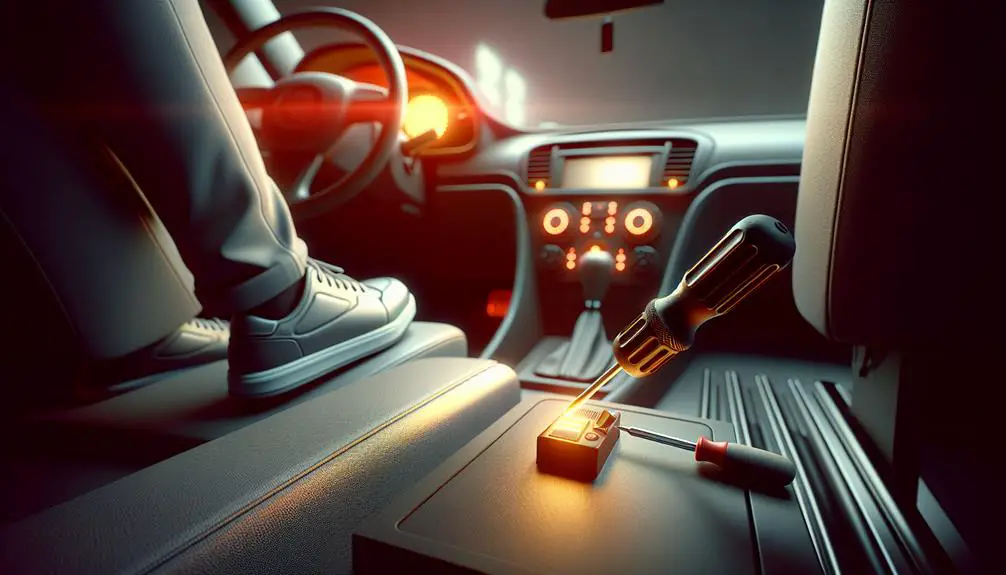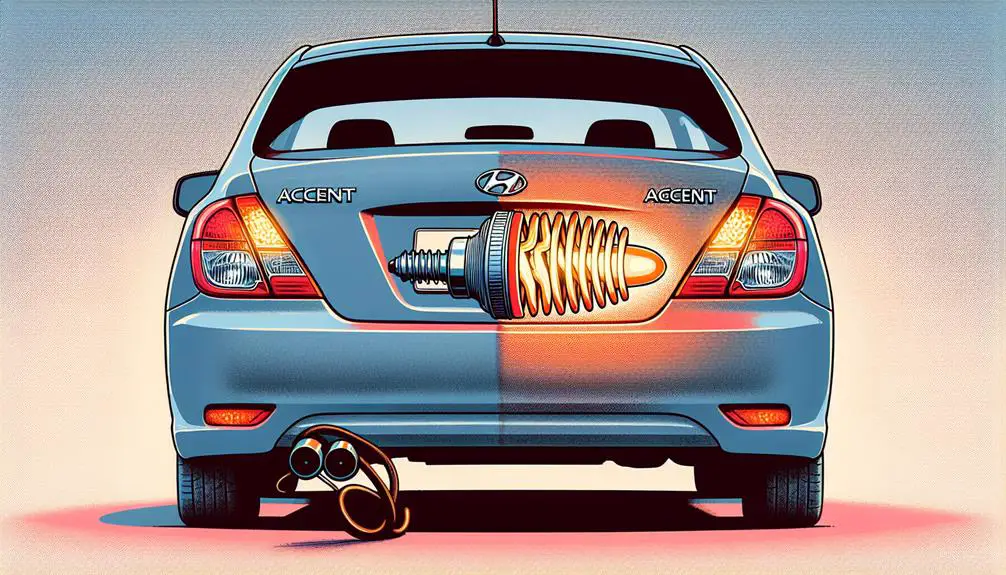Possible causes of a stuck Hyundai Accent brake light include a malfunctioning brake light switch or faulty wiring.
If the brake light switch is faulty, it may need to be replaced.
Similarly, if the wiring is damaged or broken, it will need to be repaired to ensure the brake light functions properly.
Checking the Brake Light Switch

Before diving into the repair, it's vital to check the brake light switch, as it's often the culprit behind lighting issues. If you're facing a problem where your Hyundai Accent's brake light stays on, you're not alone. This common issue can usually be traced back to a faulty brake light switch.
You'll find the brake light switch mounted near the top of the brake pedal. It's a simple mechanism that activates your brake lights when you press the pedal. When it fails, it can either cause the lights to stay on constantly or not come on at all.
To test the switch, you initially need to locate it. It's typically easy to access. Once you've found it, check if it's physically stuck. Sometimes, debris or a misalignment can cause it to remain in the 'on' position. If it appears fine but you're still experiencing issues, you might need to test its functionality with a multimeter.
Set your multimeter to the continuity setting and connect its probes to the switch's terminals. Press the brake pedal down and observe if the multimeter indicates continuity. If it doesn't, the switch is defective and needs replacement.
Replacing the brake light switch is straightforward. Disconnect the switch from the pedal assembly and unplug it from the wiring harness. Then, install the new switch by reversing these steps. Make sure it's properly adjusted so that your brake lights function correctly when the pedal is pressed.
This simple check can save you time and money, and it's a great initial step in troubleshooting your Hyundai Accent's brake light issues.
Faulty Wiring and Connections
After checking the brake light switch, it's important to inspect the wiring and connections for any signs of wear or damage. Faulty wiring or loose connections can also cause your Hyundai Accent's brake lights to stay on. This issue might seem challenging, but you can tackle it with a bit of patience and the right approach.
First, you'll need to locate the wiring harness that connects to the brake light switch. It's usually found near the brake pedal. Look for any obvious signs of damage, such as frayed wires or corrosion on the connectors. Even a small amount of corrosion can interrupt the electrical signal, causing the brake lights to malfunction.
If you find damaged wiring, it's crucial to repair or replace it immediately. For minor damage, electrical tape might provide a temporary fix, but it's always best to replace damaged wires entirely to avoid future problems. When dealing with connectors, make sure they're clean and secure. A can of compressed air can help remove any dust or debris that might hinder a good electrical connection.
Should you not spot any visible damage, it's possible that the issue lies within the wiring itself. A multimeter can be instrumental in this case. Use it to check for continuity in the wires leading to and from the brake light switch. If you find a break in continuity, you've found where the electrical signal is getting lost.
Malfunctioning Tail Light Bulbs

Having inspected the wiring and connections, it's time to examine the tail light bulbs in your Hyundai Accent for any signs of malfunction. Malfunctioning tail light bulbs could be the reason your brake light stays on. Unlike other problems, this one's pretty straightforward to diagnose and fix.
Initially, you'll need to locate your tail light assembly and access the bulbs. If you're not sure how to do this, your car's manual can guide you through the process. Once you've got access, check each bulb. You're looking for signs of damage like cracks or black spots, which indicate a bulb is burnt out.
Here's a simple table to help you understand what you might find and what it means:
| Bulb Condition | Possible Issue | Action |
|---|---|---|
| Clear and Intact | No Issue with Bulb | Check Next Bulb |
| Black Spots or Filament Broken | Bulb Burnt Out | Replace Bulb |
| Bulb Loose in Socket | Poor Connection | Secure Bulb |
| Discoloration | Bulb Aging | Consider Replacement |
Remember, bulbs can fail at any time, so if one is out, it's a good idea to replace them in pairs. This ensures even lighting and prevents you from having to do the same job twice in a short span of time.
If after replacing any faulty bulbs your brake light issue persists, it's likely not ensure to the bulbs themselves. You've eliminated one more potential cause, bringing you a step closer to solving the problem.
Issues With the Brake Pedal
If you've addressed the tail light bulbs but your Hyundai Accent's brake light remains on, it's time to check the brake pedal for potential issues.
One common culprit is the brake pedal switch, a sensor located near the top of the pedal. This switch is responsible for turning your brake lights on and off. If it's stuck or faulty, your brake lights might stay illuminated. You can test this by gently tapping the pedal to see if the light goes off. If not, the switch may need adjustment or replacement.
Over time, the switch's position can shift or its contacts can wear out, leading to constant engagement. Adjusting the switch is sometimes all it takes to fix the problem. However, if the switch is visibly damaged, you'll need to replace it. This is usually a straightforward task: disconnect the electrical connector, unscrew the switch, and install the new one.
Don't overlook the possibility of a return spring issue. This spring pulls the brake pedal back to its resting position. If it's broken or has lost tension, your pedal mightn't return fully, keeping the brake lights on. Inspect the spring for wear and replace it if necessary.
Lastly, make sure there's no debris or floor mats blocking the pedal's full range of motion. Even a small obstruction can prevent the pedal from returning to its proper position, resulting in the brake lights staying on.
Addressing these brake pedal issues should help turn off those troublesome brake lights, improving both safety and peace of mind.
Inspecting the Fuse Box

Moving on to the fuse box, it's significant you check it for any blown fuses that might be affecting your Hyundai Accent's brake light functionality. The fuse box is usually located under the dashboard on the driver's side or near the engine compartment. If you're not sure where it is, consult your Accent's owner manual for the exact location and the fuse diagram.
Once you've found the fuse box, you'll need to locate the specific fuse for the brake lights. Again, refer to the manual for its position. It's typically labeled clearly, but if you're unsure, the diagram should help you identify it. After locating the right fuse, you'll need to inspect it carefully. A blown fuse is usually easy to spot as the wire inside will be broken or the glass may appear blackened.
If you find the fuse is indeed blown, replacing it's your next step. It's significant you use a new fuse with the same amperage to avoid any electrical issues. Fuses are relatively inexpensive and can be purchased at any auto parts store. Simply remove the old fuse, usually by pulling it out with a fuse puller or a pair of needle-nose pliers, and insert the new one in its place.
After replacing the fuse, check your brake lights again. If they're now functioning properly, you've solved the issue. However, if the brake light stays on or the new fuse blows shortly after installation, there might be a deeper electrical problem that requires professional attention. Remember, safety comes first, so don't hesitate to seek help if you're in over your head.
Conclusion
To sum up, if your Hyundai Accent's brake light won't turn off, you've got a few key areas to check out. Start by inspecting the brake light switch and then move onto any faulty wiring or connections.
Don't overlook the tail light bulbs and the brake pedal itself for any issues. Finally, a quick peek into the fuse box could reveal some answers.
Tackling these areas should help you get those brake lights functioning properly again in no time.